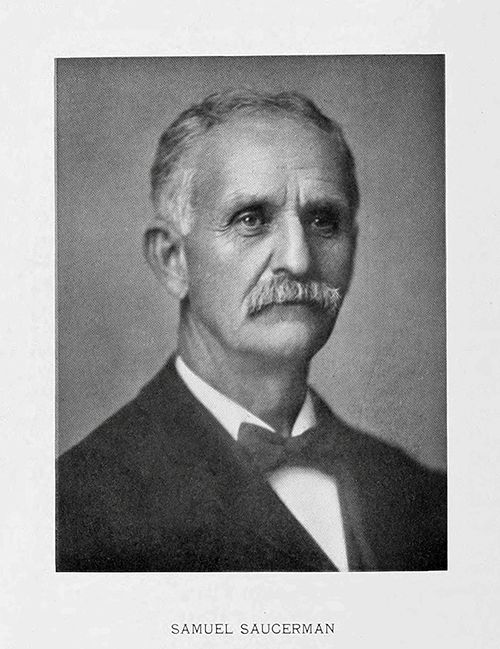Though not a pioneer of Polk County, Samuel Saucerman has been identified with its business growth and prosperity, and that of Des Moines, for nearly forty years.
Born in Coshocton County, Ohio, February Fifteenth, 1840, of German ancestry, when six years old his parents emigrated to Green County, Wisconsin, where his father purchased one hundred and sixty acres of wild land in a sparsely settled country, and opened a farm. Being a carpenter and builder, he escaped many of the discomforts of pioneer settlers. Deer, wild turkeys, prairie chickens, pheasant, quail, rabbits, and squirrels were abundant, the streams alive with the most delicious specimens of the finny tribe, the speckled trout, so that the meat supply only required the gathering of it when wanted.
There Samuel passed his youth, doing the general utility work of a farm boy during the Summer; in the Winter going to the district school, and chopping wood.
When sixteen years old, his father died, and for four years following, he managed the farm, got it well supplied with grain and live stock, and then turned it over to his mother, three younger brothers and a sister, and started off to “find his fortune.”
He purchased timber land, hired men to cut down the trees, cut them into lumber, fence rails, and cordwood, which were sold to prairie farmers, some of whom came twenty miles to get them.
He thus accumulated several golden shekels, and, in 1868, came to Des Moines. It was not a very attractive place to a stranger from the backwoods of Wisconsin. There were no paved streets, only a few poor sidewalks; most of the business was done on Second Street and Court Avenue below Third. Doctor Turner was planting rails and ties in the mud on Walnut Street for his street cars, drawn by horses and mules, which, most of the time, were floundering broadside down in the slippery, sticky clay.The county was comparatively unsettled. Unimproved land was selling at ten dollars to fifteen dollars an acre.
After surveying the field, he concluded the town was bound to grow; that with its growth the people must have places to live and homes. He therefore pinned his faith to real estate. He purchased several small tracts of timber land nearby, hired men to cut the trees into cordwood, and haul it into town, where it was sold at five and six dollars per cord, as everybody used wood at that time for heating purposes. He also purchased several small tracts inside the town, platted them into building lots, sold them to mechanics, furnishing them lumber to build a house, on easy payments, without interest or rent, thus enabling them to get a home. Later, he purchased a large tract north and west of Drake University, when the mud was so deep on Cottage Grove Avenue and what is now University Avenue it was difficult for a horse to pull a buggy through it. There were also but few houses scattered along either street.
He platted his large tract into lots, donated to the city eight acres of it for streets, opened Hickman Avenue, dug out the trees and underbrush, and graded the roadbed from Twentieth to Thirtieth Street. He also did the same on Thirtieth Street, from University Avenue to a point one-half mile north of Hickman Avenue. Land that then was purchased for twenty dollars an acre could not be had to-day for five hundred dollars an acre. That University Avenue would ever be adorned with the magnificent university, with its environments; the elegant residences that now beautify it; that street cars would traverse it, or electricity illuminate it, was beyond the conception or dream of the most optimistic city booster, though Saucerman was quite radical, for he always declared that Des Moines would become what Indianapolis is to Indiana; that it would be the one great central, up-to-date city of the state, with smaller towns surrounding and tributary to it; that interurban roads radiating in all directions, with quick transit and low rates, would inevitably and rapidly increase its growth and prosperity. Being thus optimistic, he started in to help build and improve the town.
After thirty-six years of labor, averaging fourteen to sixteen hours a day, and for more than twenty years paying annually into the county treasury as taxes over one thousand dollars; selling over two thousand building lots; assisting many laboring men to secure homes, he can very justly be classed as one of the boosters.
Politically, he is a Republican, and votes the national ticket of that party. He takes no part in politics; never held a public office; would not take one if he could get it. In state, county and city affairs, he votes for the man he believes will best subserve the public well-being.
Socially, he is plain, unostentatious, of kindly temperament, a good neighbor and good citizen. Is not a member of any social clubs or fraternal organizations, being opposed to secret societies of every kind, regardless of their object or purpose.
Religiously, he holds a membership in the Central Christian Church, but does not accept all its tenets.
A dominant trait of his character is independence of thought and action. He believes in open, frank, square dealing in business, politics and religion; that a true American citizen is one of the highest types of manhood.
December Sixteenth, 1906.
Click here for a PDF document of this biography - Easy printing and page numbers for reference.
Copyright © 1996
The IAGenWeb Project
IAGenWeb Terms, Conditions & Disclaimer


